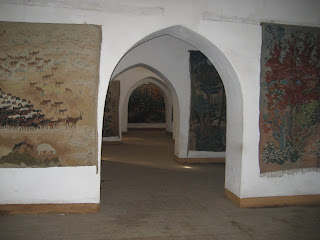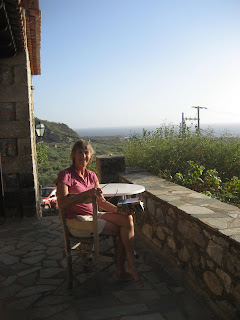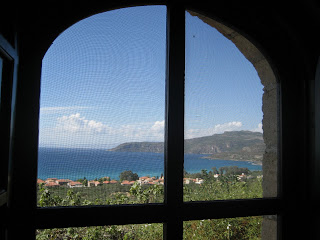




Day 71. Tuesday, October 12th. Delphi, Greece.
We landed in Pireaus (Athens’ port) at 6.00am but then took 4 hours to get a rental car. I had booked at Budget but they told me that I needed an International Driver’s license. Rick Steve’s and other guidebooks tell you that an American Driver’s License is good for six months---going to e mail Rick. The Budget guy makes handcuff signs and explains to me that is what will happen if the Police stop me. He telephones Hertz for me and they agree to rent me a car (for more money of course) while agreeing that it is illegal.
We drive the four hours to Delphi. (“Delphee”). The Greeks have built a lot of good new roads and bridges. We climb up into the mountains and mist, through winter ski resorts and arrive at the town of Delphi. Christine and I do the usual walk about town checking Hotels and rooms and bouncing on beds and looking at balcony views before choosing room 14, Hotel Pan. Good views all down the valley to the Gulf of Corinth.
Then we visit the ancient ruins of Delphi, home of the Oracle and it is stunning-perched half way up the valley side. Sophocles and others came to visit and seek the wisdom of the old woman there who spoke in riddles. Big gifts let you jump the queue. Alexander the Great asked her if he was going to conquer the world and when she hummed and hawed he grabbed her by the hair and she cried out that he was unstoppable. “I have the answer I want” he said and released her. The new museum that has been built to house all of the statues etc that they have found at the site is wonderful.
An entrepreneur has opened a consulting business in town called Delphi Consulting.
Just down the road from the main site if the Temple of Athena and it’s guarded by an old Greek fellow who maintains a strict discipline for visitors to his site. No litter, no sitting on the ancient stones and no taking pictures of yourself and friends with the ruins and statues. (That’s pretty common in Greece, they don’t mind you taking pictures of the statues but you cannot be in the picture-they think it diminishes the majesty and grace of their history). He won’t tell me his name (“Bill” he calls himself when asked) and won’t let his picture be taken but he tells me that he has been guarding the site since he was a little boy. Then we argue about each other’s age and he tells me that he is the only one left of his 5 brothers and 3 sisters. (This is all done by hand-waving). Then, after we have told him that we are English, he gets all excited and starts to pull us over to a fallen column and points with his stick at some ancient graffiti etched into the column shouting “burron, burron” and, sure enough, there is Lord Byron’s name etched into the column. We have to research this, none of the guide books mention it but we do know that Lord Byron did come here with Shelley (and Shelly’s sister Mary (Frankenstein) as did other romantics to help the Greeks fight the Turks. So it seems at least possible, the graffiti seems about the right age.
Wonderful site, just as I remembered it from when I visited it when I was twenty.
Rainy day today which was OK. Dinner at Vakchos Taverna and great.

















































